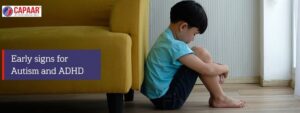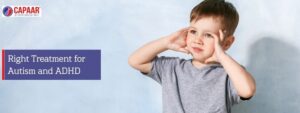ADHD and Autism Treatment in Bangalore | CAPAAR
The first glance is not always enough to understand the difference between ADHD and autism as they share many common traits. Trouble regulating emotions, impulsive control challenges, struggle with basic functions, and tough reading social cues are the most common challenges found in both ADHD and autism.
ADHD and autism can crop up together. Signs shown by autism, also known as autism spectrum disorder or ASD can show different signs of severity. Autism varies in symptoms that can differ from one child to another. So, what are the significant differences between ADHD and autism? Read on to learn more.
What is the actuality?
ADHD is a neurodevelopmental condition that makes a child pay attention, sit still, concentrate, and retrain impulsiveness.
Autism is a wide range of neurodevelopmental challenges that result in difficulty in thinking, communication, and social skills. Monotonous behavior is also a part of autism spectrum disorder or ASD.
What are the early signs to notice in your child?

Get the best ADHD and Autism Treatment in Bangalore at CAPAAR by the best ADHD and Autism specialist in Bangalore. Below are the few things to look out for ADHD in your child,
- Is daydreamy, forgetful, and gets easily distracted.
- Struggles to complete tasks and be organized.
- Trouble following instructions.
- Disinterested to stay in one task if it does not seem interesting.
- Frequent meltdowns and tantrums due to frustration and impulsive condition.
- Difficulty in coping with social skills.
- Impatience to wait for a turn.
- Tough to stay quiet during independent work times.
- Always on the go, meddles, and fidgets with anything around.
- Play rough and act blindly without thinking about the physical consequences.
- Cause interruption and sudden inappropriate babble.
- Can overreact to some sensory inputs like how something tastes, smells, sounds, looks, or feels.
Look out for the following symptoms in case of autism,
- Avoids physical or eye contact with no speech, speech delay, or repeated phrases.
- Lack social skills and easily get upset with changes in a simple routine.
- Shows Communication difficulty, anxiety, frustration, and sensory processing issues.
- Makes extreme repetitive body movements like flapping hands, rocking, etc., to soothe themselves.
- Has obsessive interests and reacts strongly to various sounds, smells, or tastes.
- Constant moving around and fidgeting with things around.
- Is distressed to understand self and others’ feelings, safety, and danger concerns.
- Sometimes there are advanced verbal signs but struggle with nonverbal cues.
What is the probable emotional and social impact?
The concern with ADHD is that there are challenges in following social rules and end up having no friends. Constant negative feedback and protests for not following instructions demotivate and impact their social esteem negatively. They feel bad and unworthy of themselves.
While in ASD, there is repetitive behavior and a lack of communication and social understanding. A child with even a slight cognitive challenge finds it difficult to interact with friends and communicate to understand and relate with others with social intimations.
Who can help in such cases?
Professional help can be looked for where they assist in overcoming such challenges with the help of early intervention and proper therapies given at the right time by the best autism Centre in Bangalore.

In the case of ADHD, pediatric neurologists, pediatricians, developmental and behavioral professionals, and child psychiatrists can watch out for anxiety, diagnose ADHD and prescribe appropriate medications. Clinical child psychologists offer behavior therapy to manage actions and interactions. Cognitive-behavioral therapy helps a child to overcome emotional hassles. Learning differences and milestone achievement that co-occur with anxiety are also assessed.
When it comes to ASD, to diagnose and identify the possible early signs of autism and provide early intervention, professionals like pediatricians, neurologists, child psychiatrists, development-behavior pediatricians, and psychologists come into service. Social workers and clinical child psychologists provide social skills training and therapies to improve social interactions. They evaluate a child on learning gaps, provide cognitive behavior therapy, and diagnose other related issues that can coexist with autism-like ADHD.
Pediatric neuropsychologists detect autism and relatable issues like ADHD, and anxiety and prescribe medication for the same. Occupational therapies are provided to help children to learn skills and take control of difficult situations. Sensory integration therapy and sensory diet make them respond to sensory inputs positively. Speech therapists in Hulimavu, Bangalore work on language and rational language skills to help them communicate and understand others easily.
In what way can the school help?
A child can be accommodated in a specific category and made eligible for certain relaxations. A child with ADHD can be made comfortable in school with a few exercises like providing a quieter space or a seat close to the teacher to avoid distractions. A non-verbal sign, signal, or flash card can hold their attention. Daily activities can be performed with a picture or written schedules. Helping them break long assignments into smaller sections. They must also be given a chance for regular movement breaks.
Similarly, a child with autism can be accommodated in a special category with appropriate relaxations as each autistic child is different. They can be seated close to the teacher with easy access to study materials. There can be a space made available with limited audio and visual distractions. Color codes and visual prompts can be used to teach new lessons along with stories to represent new situations and ideas to deal with them. Sensory activities and diets can be planned for the day. Such children can be relaxed with some wait time and given options to control their anxiety.
What measures can be taken at home?
To deal with ADHD at home, it is better to initially set expectations and rules for your child. Create structural daily routines where tasks can be broken into smaller chunks. You can teach your child to stay organized to get things done and use visual props like sticky notes, pictures, and checklists. Grant more movement breaks, and flexibility during homework and assignments. Make an organized space for them to study, eat and sleep. They must be given a warning about any change in schedule and ways to adapt to the new schedule and situation.
When you have an autistic child at home, you can similarly create daily plans and expectations. Help them break routine tasks into smaller ones with visual props. Most importantly, they must be taught to handle meltdowns. Visual prompts and role-plays are helpful to a great extent to signal and transit from one situation to another. As ASD is different in every child, the support provided at home also varies with each child. Parents need to work closely with clinicians and psychologists to create a unique support plan for their children.

